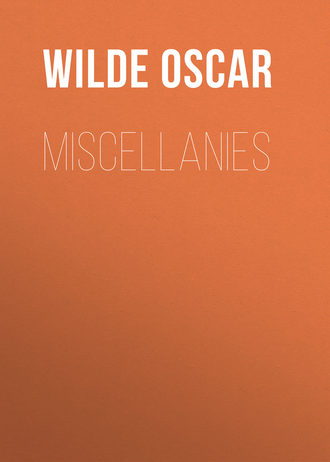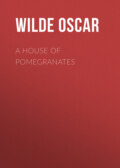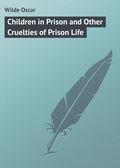
Оскар Уайльд
Miscellanies
Her lord and liege,
Her seer, her bard, her silver star of eve,
Her god, her Merlin, the one passionate love
Of her whole life.
In her brown crisp hair is the gleam of a golden snake, and she is clad in a silken robe of dark violet that clings tightly to her limbs, more expressing than hiding them; the colour of this dress is like the colour of a purple sea-shell, broken here and there with slight gleams of silver and pink and azure; it has a strange metallic lustre like the iris-neck of the dove. Were this Mr. Burne-Jones’s only work it would be enough of itself to make him rank as a great painter. The picture is full of magic; and the colour is truly a spirit dwelling on things and making them expressive to the spirit, for the delicate tones of grey, and green, and violet seem to convey to us the idea of languid sleep, and even the hawthorn-blossoms have lost their wonted brightness, and are more like the pale moonlight to which Shelley compared them, than the sheet of summer snow we see now in our English fields.
The next picture is divided into six compartments, each representing a day in the Creation of the World, under the symbol of an angel holding a crystal globe, within which is shown the work of a day. In the first compartment stands the lonely angel of the First Day, and within the crystal ball Light is being separated from Darkness. In the fourth compartment are four angels, and the crystal glows like a heated opal, for within it the creation of the Sun, Moon, and Stars is passing; the number of the angels increases, and the colours grow more vivid till we reach the sixth compartment, which shines afar off like a rainbow. Within it are the six angels of the Creation, each holding its crystal ball; and within the crystal of the sixth angel one can see Adam’s strong brown limbs and hero form, and the pale, beautiful body of Eve. At the feet also of these six winged messengers of the Creator is sitting the angel of the Seventh Day, who on a harp of gold is singing the glories of that coming day which we have not yet seen. The faces of the angels are pale and oval-shaped, in their eyes is the light of Wisdom and Love, and their lips seem as if they would speak to us; and strength and beauty are in their wings. They stand with naked feet, some on shell-strewn sands whereon tide has never washed nor storm broken, others it seems on pools of water, others on strange flowers; and their hair is like the bright glory round a saint’s head.
The scene of the third picture is laid on a long green valley by the sea; eight girls, handmaidens of the Goddess of Love, are collected by the margin of a long pool of clear water, whose surface no wandering wind or flapping bird has ruffled; but the large flat leaves of the water-lily float on it undisturbed, and clustering forget-me-nots rise here and there like heaps of scattered turquoise.
In this Mirror of Venus each girl is reflected as in a mirror of polished steel. Some of them bend over the pool in laughing wonder at their own beauty, others, weary of shadows, are leaning back, and one girl is standing straight up; and nothing of her is reflected in the pool but a glimmer of white feet. This picture, however, has not the intense pathos and tragedy of the Beguiling of Merlin, nor the mystical and lovely symbolism of the Days of the Creation. Above these three pictures are hung five allegorical studies of figures by the same artist, all worthy of his fame.
Mr. Walter Crane, who has illustrated so many fairy tales for children, sends an ambitious work called the Renaissance of Venus, which in the dull colour of its ‘sunless dawn,’ and in its general want of all the glow and beauty and passion that one associates with this scene reminds one of Botticelli’s picture of the same subject. After Mr. Swinburne’s superb description of the sea-birth of the goddess in his Hymn to Proserpine, it is very strange to find a cultured artist of feeling producing such a vapid Venus as this. The best thing in it is the painting of an apple tree: the time of year is spring, and the leaves have not yet come, but the tree is laden with pink and white blossoms, which stand out in beautiful relief against the pale blue of the sky, and are very true to nature.
M. Alphonse Legros sends nine pictures, and there is a natural curiosity to see the work of a gentleman who holds at Cambridge the same professorship as Mr. Ruskin does at Oxford. Four of these are studies of men’s heads, done in two hours each for his pupils at the Slade Schools. There is a good deal of vigorous, rough execution about them, and they are marvels of rapid work. His portrait of Mr. Carlyle is unsatisfactory; and even in No. 79, a picture of two scarlet-robed bishops, surrounded by Spanish monks, his colour is very thin and meagre. A good bit of painting is of some metal pots in a picture called Le Chaudronnier.
Mr. Leslie, unfortunately, is represented only by one small work, called Palm-blossom. It is a picture of a perfectly lovely child that reminds one of Sir Joshua’s cherubs in the National Gallery, with a mouth like two petals of a rose; the under-lip, as Rossetti says quaintly somewhere, ‘sucked in, as if it strove to kiss itself.’
Then we come to the most abused pictures in the whole Exhibition – the ‘colour symphonies’ of the ‘Great Dark Master,’ Mr. Whistler, who deserves the name of ‘Ο σκοτεινος as much as Heraclitus ever did. Their titles do not convey much information. No. 4 is called Nocturne in Black and Gold, No. 6A Nocturne in Blue and Silver, and so on. The first of these represents a rocket of golden rain, with green and red fires bursting in a perfectly black sky, two large black smudges on the picture standing, I believe, for a tower which is in ‘Cremorne Gardens’ and for a crowd of lookers-on. The other is rather prettier; a rocket is breaking in a pale blue sky over a large dark blue bridge and a blue and silver river. These pictures are certainly worth looking at for about as long as one looks at a real rocket, that is, for somewhat less than a quarter of a minute.
No. 7 is called Arrangement in Black No. 3, apparently some pseudonym for our greatest living actor, for out of black smudgy clouds comes looming the gaunt figure of Mr. Henry Irving, with the yellow hair and pointed beard, the ruff, short cloak, and tight hose in which he appeared as Philip II. in Tennyson’s play Queen Mary. One hand is thrust into his breast, and his legs are stuck wide apart in a queer stiff position that Mr. Irving often adopts preparatory to one of his long, wolflike strides across the stage. The figure is life-size, and, though apparently one-armed, is so ridiculously like the original that one cannot help almost laughing when one sees it. And we may imagine that any one who had the misfortune to be shut up at night in the Grosvenor Gallery would hear this Arrangement in Black No. 3 murmuring in the well-known Lyceum accents:
By St. James, I do protest,
Upon the faith and honour of a Spaniard,
I am vastly grieved to leave your Majesty.
Simon, is supper ready?
Nos. 8 and 9 are life-size portraits of two young ladies, evidently caught in a black London fog; they look like sisters, but are not related probably, as one is a Harmony in Amber and Black, the other only an Arrangement in Brown.
Mr. Whistler, however, sends one really good picture to this exhibition, a portrait of Mr. Carlyle, which is hung in the entrance hall; the expression on the old man’s face, the texture and colour of his grey hair, and the general sympathetic treatment, show Mr. Whistler3 to be an artist of very great power when he likes.
There is not so much in the East Gallery that calls for notice. Mr. Leighton is unfortunately represented only by two little heads, one of an Italian girl, the other called A Study. There is some delicate flesh painting of red and brown in these works that reminds one of a russet apple, but of course they are no samples of this artist’s great strength. There are two good portraits – one of Mrs. Burne-Jones, by Mr. Poynter. This lady has a very delicate, artistic face, reminding us, perhaps, a little of one of the angels her husband has painted. She is represented in a white dress, with a perfectly gigantic old-fashioned watch hung to her waist, drinking tea from an old blue china cup. The other is a head of the Duchess of Westminster by Mr. Forbes-Robertson, who both as an actor and an artist has shown great cleverness. He has succeeded very well in reproducing the calm, beautiful profile and lustrous golden hair, but the shoulders are ungraceful, and very unlike the original. The figure of a girl leaning against a wonderful screen, looking terribly ‘misunderstood,’ and surrounded by any amount of artistic china and furniture, by Mrs. Louise Jopling, is worth looking at too. It is called It Might Have Been, and the girl is quite fit to be the heroine of any sentimental novel.
The two largest contributors to this gallery are Mr. Ferdinand Heilbuth and Mr. James Tissot. The first of these two artists sends some delightful pictures from Rome, two of which are particularly pleasing. One is of an old Cardinal in the Imperial scarlet of the Cæsars meeting a body of young Italian boys in purple soutanes, students evidently in some religious college, near the Church of St. John Lateran. One of the boys is being presented to the Cardinal, and looks very nervous under the operation; the rest gaze in wonder at the old man in his beautiful dress. The other picture is a view in the gardens of the Villa Borghese; a Cardinal has sat down on a marble seat in the shade of the trees, and is suspending his meditation for a moment to smile at a pretty child to whom a French bonne is pointing out the gorgeously dressed old gentleman; a flunkey in attendance on the Cardinal looks superciliously on.
Nearly all of Mr. Tissot’s pictures are deficient in feeling and depth; his young ladies are too fashionably over-dressed to interest the artistic eye, and he has a hard unscrupulousness in painting uninteresting objects in an uninteresting way. There is some good colour and drawing, however, in his painting of a withered chestnut tree, with the autumn sun glowing through the yellow leaves, in a picnic scene, No. 23; the remainder of the picture being something in the photographic style of Frith.
What a gap in art there is between such a picture as the Banquet of the Civic Guard in Holland, with its beautiful grouping of noble-looking men, its exquisite Venetian glass aglow with light and wine, and Mr. Tissot’s over-dressed, common-looking people, and ugly, painfully accurate representation of modern soda-water bottles!
Mr. Tissot’s Widower, however, shines in qualities which his other pictures lack; it is full of depth and suggestiveness; the grasses and wild, luxuriant growth of the foreground are a revel of natural life.
We must notice besides in this gallery Mr. Watts’s two powerful portraits of Mr. Burne-Jones and Lady Lindsay.
To get to the Water-Colour Room we pass through a small sculpture gallery, which contains some busts of interest, and a pretty terra-cotta figure of a young sailor, by Count Gleichen, entitled Cheeky, but it is not remarkable in any way, and contrasts very unfavourably with the Exhibition of Sculpture at the Royal Academy, in which are three really fine works of art – Mr. Leighton’s Man Struggling with a Snake, which may be thought worthy of being looked on side by side with the Laocoon of the Vatican, and Lord Ronald Gower’s two statues, one of a dying French Guardsman at the Battle of Waterloo, the other of Marie Antoinette being led to execution with bound hands, Queenlike and noble to the last.
The collection of water-colours is mediocre; there is a good effect of Mr. Poynter’s, the east wind seen from a high cliff sweeping down on the sea like the black wings of some god; and some charming pictures of Fairy Land by Mr. Richard Doyle, which would make good illustrations for one of Mr. Allingham’s Fairy-Poems, but the tout-ensemble is poor.
Taking a general view of the works exhibited here, we see that this dull land of England, with its short summer, its dreary rains and fogs, its mining districts and factories, and vile deification of machinery, has yet produced very great masters of art, men with a subtle sense and love of what is beautiful, original, and noble in imagination.
Nor are the art-treasures of this country at all exhausted by this Exhibition; there are very many great pictures by living artists hidden away in different places, which those of us who are yet boys have never seen, and which our elders must wish to see again.
Holman Hunt has done better work than the Afterglow in Egypt; neither Millais, Leighton, nor Poynter has sent any of the pictures on which his fame rests; neither Burne-Jones nor Watts shows us here all the glories of his art; and the name of that strange genius who wrote the Vision of Love revealed in Sleep, and the names of Dante Rossetti and of the Marchioness of Waterford, cannot be found in the catalogue. And so it is to be hoped that this is not the only exhibition of paintings that we shall see in the Grosvenor Gallery; and Sir Coutts Lindsay, in showing us great works of art, will be most materially aiding that revival of culture and love of beauty which in great part owes its birth to Mr. Ruskin, and which Mr. Swinburne, and Mr. Pater, and Mr. Symonds, and Mr. Morris, and many others, are fostering and keeping alive, each in his own peculiar fashion.
THE GROSVENOR GALLERY 1879
(Saunders’ Irish Daily News, May 5, 1879.)
While the yearly exhibition of the Royal Academy may be said to present us with the general characteristics of ordinary English art at its most commonplace level, it is at the Grosvenor Gallery that we are enabled to see the highest development of the modern artistic spirit as well as what one might call its specially accentuated tendencies.
Foremost among the great works now exhibited at this gallery are Mr. Burne-Jones’s Annunciation and his four pictures illustrating the Greek legend of Pygmalion – works of the very highest importance in our æsthetic development as illustrative of some of the more exquisite qualities of modern culture. In the first the Virgin Mary, a passionless, pale woman, with that mysterious sorrow whose meaning she was so soon to learn mirrored in her wan face, is standing, in grey drapery, by a marble fountain, in what seems the open courtyard of an empty and silent house, while through the branches of a tall olive tree, unseen by the Virgin’s tear-dimmed eyes, is descending the angel Gabriel with his joyful and terrible message, not painted as Angelico loved to do, in the varied splendour of peacock-like wings and garments of gold and crimson, but somewhat sombre in colour, set with all the fine grace of nobly-fashioned drapery and exquisitely ordered design. In presence of what may be called the mediæval spirit may be discerned both the idea and the technique of the work, and even still more so in the four pictures of the story of Pygmalion, where the sculptor is represented in dress and in looks rather as a Christian St. Francis, than as a pure Greek artist in the first morning tide of art, creating his own ideal, and worshipping it. For delicacy and melody of colour these pictures are beyond praise, nor can anything exceed the idyllic loveliness of Aphrodite waking the statue into sensuous life: the world above her head like a brittle globe of glass, her feet resting on a drift of the blue sky, and a choir of doves fluttering around her like a fall of white snow. Following in the same school of ideal and imaginative painting is Miss Evelyn Pickering, whose picture of St. Catherine, in the Dudley of some years ago, attracted such great attention. To the present gallery she has contributed a large picture of Night and Sleep, twin brothers floating over the world in indissoluble embrace, the one spreading the cloak of darkness, while from the other’s listless hands the Leathean poppies fall in a scarlet shower. Mr. Strudwich sends a picture of Isabella, which realises in some measure the pathos of Keats’s poem, and another of the lover in the lily garden from the Song of Solomon, both works full of delicacy of design and refinement of detail, yet essentially weak in colour, and in comparison with the splendid Giorgione-like work of Mr. Fairfax Murray, are more like the coloured drawings of the modern German school than what we properly call a painting. The last-named artist, while essentially weak in draughtsmanship, yet possesses the higher quality of noble colour in the fullest degree.
The draped figures of men and women in his Garland Makers, and Pastoral, some wrought in that single note of colour which the earlier Florentines loved, others with all the varied richness and glow of the Venetian school, show what great results may be brought about by a youth spent in Italian cities. And finally I must notice the works contributed to this Gallery by that most powerful of all our English artists, Mr. G. F. Watts, the extraordinary width and reach of whose genius were never more illustrated than by the various pictures bearing his name which are here exhibited. His Paolo and Francesca, and his Orpheus and Eurydice, are creative visions of the very highest order of imaginative painting; marked as it is with all the splendid vigour of nobly ordered design, the last-named picture possesses qualities of colour no less great. The white body of the dying girl, drooping like a pale lily, and the clinging arms of her lover, whose strong brown limbs seem filled with all the sensuous splendour of passionate life, form a melancholy and wonderful note of colour to which the eye continually returns as indicating the motive of the conception. Yet here I would dwell rather on two pictures which show the splendid simplicity and directness of his strength, the one a portrait of himself, the other that of a little child called Dorothy, who has all that sweet gravity and look of candour which we like to associate with that old-fashioned name: a child with bright rippling hair, tangled like floss silk, open brown eyes and flower-like mouth; dressed in faded claret, with little lace about the neck and throat, toned down to a delicate grey – the hands simply clasped before her. This is the picture; as truthful and lovely as any of those Brignoli children which Vandyke has painted in Genoa. Nor is his own picture of himself – styled in the catalogue merely A Portrait– less wonderful, especially the luminous treatment of the various shades of black as shown in the hat and cloak. It would be quite impossible, however, to give any adequate account or criticism of the work now exhibited in the Grosvenor Gallery within the limits of a single notice. Richmond’s noble picture of Sleep and Death Bearing the Slain Body of Sarpedon, and his bronze statue of the Greek athlete, are works of the very highest order of artistic excellence, but I will reserve for another occasion the qualities of his power. Mr. Whistler, whose wonderful and eccentric genius is better appreciated in France than in England, sends a very wonderful picture entitled The Golden Girl, a life-size study in amber, yellow and browns, of a child dancing with a skipping-rope, full of birdlike grace and exquisite motion; as well as some delightful specimens of etching (an art of which he is the consummate master), one of which, called The Little Forge, entirely done with the dry point, possesses extraordinary merit; nor have the philippics of the Fors Clavigera deterred him from exhibiting some more of his ‘arrangements in colour,’ one of which, called a Harmony in Green and Gold, I would especially mention as an extremely good example of what ships lying at anchor on a summer evening are from the ‘Impressionist point of view.’
Mr. Eugene Benson, one of the most cultured of those many Americans who seem to have found their Mecca in modern Rome, has sent a picture of Narcissus, a work full of the true Theocritean sympathy for the natural picturesqueness of shepherd life, and entirely delightful to all who love the peculiar qualities of Italian scenery. The shadows of the trees drifting across the grass, the crowding together of the sheep, and the sense of summer air and light which fills the picture, are full of the highest truth and beauty; and Mr. Forbes-Robertson, whose picture of Phelps as Cardinal Wolsey has just been bought by the Garrick Club, and who is himself so well known as a young actor of the very highest promise, is represented by a portrait of Mr. Hermann Vezin which is extremely clever and certainly very lifelike. Nor amongst the minor works must I omit to notice Miss Stuart-Wortley’s view on the river Cherwell, taken from the walks of Magdalen College, Oxford, – a little picture marked by great sympathy for the shade and coolness of green places and for the stillness of summer waters; or Mrs. Valentine Bromley’s Misty Day, remarkable for the excellent drawing of a breaking wave, as well as for a great delicacy of tone. Besides the Marchioness of Waterford, whose brilliant treatment of colour is so well known, and Mr. Richard Doyle, whose water-colour drawings of children and of fairy scenes are always so fresh and bright, the qualities of the Irish genius in the field of art find an entirely adequate exponent in Mr. Wills, who as a dramatist and a painter has won himself such an honourable name. Three pictures of his are exhibited here: the Spirit of the Shell, which is perhaps too fanciful and vague in design; the Nymph and Satyr, where the little goat-footed child has all the sweet mystery and romance of the woodlands about him; and the Parting of Ophelia and Laertes, a work not only full of very strong drawing, especially in the modelling of the male figure, but a very splendid example of the power of subdued and reserved colour, the perfect harmony of tone being made still more subtle by the fitful play of reflected light on the polished armour.
I shall reserve for another notice the wonderful landscapes of Mr. Cecil Lawson, who has caught so much of Turner’s imagination and mode of treatment, as well as a consideration of the works of Herkomer, Tissot and Legros, and others of the modern realistic school.
Note. – The other notice mentioned above did not appear.






